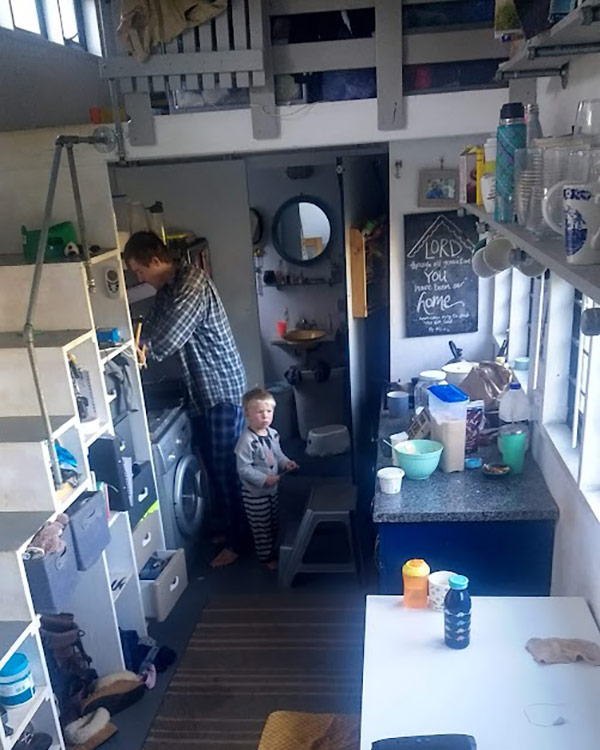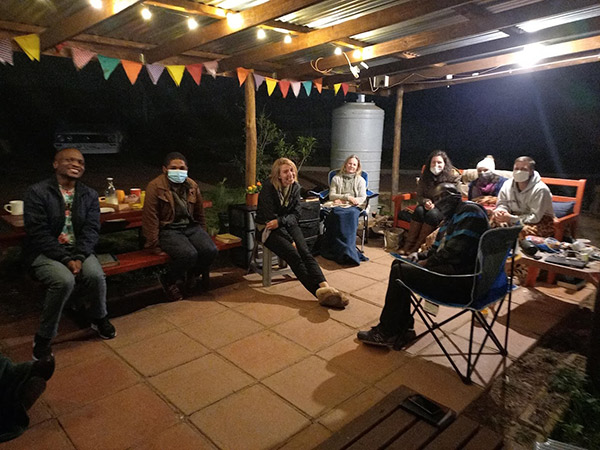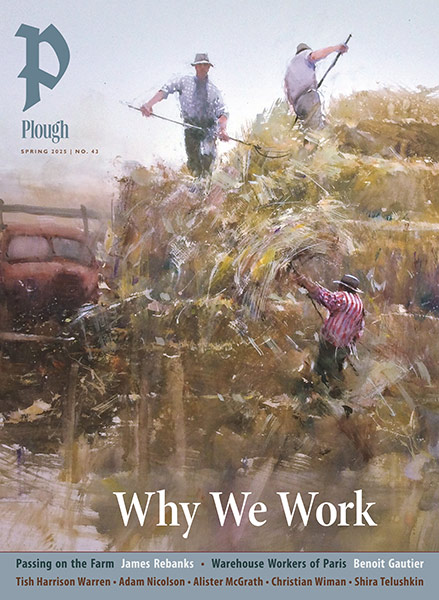Subtotal: $
Checkout
Tiny House Living
I learned a few things from my attempt at the simple life in a tiny hand-built home for three, then four…
By Stephanie Ebert
October 9, 2024
I like to think that Saint Francis is the patron saint of Tiny Houses. He was known for simplicity, after all. And I like to think that my alternative lifestyle choices are blessed by a saint. I say Tiny House, capital letters, because what we lived in was not a cramped 180-foot-square apartment in a big city; it was a Tiny House. It was designed. It had a full kitchen and two sleeping lofts, and wheels. It was hand-built by my husband and his father. Our intentional attempt at a simple life.
We first stumbled across Tiny House living on the internet in 2015. My husband was in a grad program in Texas. We had just finished hiking the Camino de Santiago pilgrimage, where we experienced both the radical hospitality of the churches and hostels in Spain that host pilgrims, and the freedom and simplicity of living out of just a backpack. The beauty of something well designed yet minimal spoke to us.
Our first night sleeping in a Tiny House on wheels happened on a road trip to New England in the early spring. The Tiny House was built of hardwood with simple, Scandinavian-style furnishings, advertised online with sweeping drone shots of the house nestled in the Vermont forests. An affordable “off-grid” getaway. It was a way to disconnect from the chaos of the city. Pure. Simple. The way life is supposed to be. There were tiny bottles of biodegradable shampoo left for us, and a composting toilet. There was a tiny stove, a mini fridge, and a solar panel keeping the lights on. This Tiny House promised both self-sufficiency and a tiny rebellion against the housing market collapse on Wall Street a few hours away.

All photographs courtesy of the author.
In fact, we had come earlier that day not from New York City, but from Concord, Massachusetts, home of Transcendentalist philosophers like Ralph Waldo Emerson and Henry David Thoreau. Emerson preached the value of self-reliance, or authenticity – why live by other people’s untested values? You’re an individual. Live by your own values. Thoreau took him up on it, opted out of the massive mortgage cycle of the Concord farming community, and built himself a Tiny House on the banks of Walden Pond.
Thoreau’s Tiny House was much smaller than the one we slept in that night – only ten by fifteen feet – though bigger than the railroad box that gave him the idea, and slightly bigger than a coffin. At least it would keep you dry in the rain. As Thoreau says, “Many a man is harassed to death to pay the rent of a larger and more luxurious box who would not have frozen to death in such a box as this.”
Thoreau did not plan to live at Walden Pond forever. But living in a house he built himself, trying to strip the clutter of society from his life to figure out what he really needed in order to live – it was an experiment in clarity, in self-sufficiency.
I had spent the last five years working for a South African nonprofit founded on principles of asset-based community development and the idea that we have the God-given potential to build community-based solutions. Self-sufficiency, no handouts – this was familiar language.
Of course, our Tiny House wasn’t as trendy as the ones on popular home-design TV shows. We had an actual budget, no building experience, and were living in South Africa, where the primary building materials were brick and mortar, not wood and insulated house wrap. There was no Instagrammable salvaging of timber from old farmhouses, just my husband trying not to get ulcers as he determined the next step of the building process with the help of YouTube. We couldn’t afford expensive flooring and ended up with painted plywood, which rapidly chipped in our galley kitchen as we walked to and fro from the bathroom to the couch. There were times, in the four-plus years when our little family lived there, that I felt ashamed of the Tiny House.
I felt ashamed when my neighbors from the wealthy suburbs where we went to church came to visit. The worn-out floor, the wooden walls warping from the rain and damp, the piles of toys and recycling scattered in the yard outside, the muddy handprints on our white walls. When I was in labor with my second child, the doula arrived and paused at the door, looking askance. Our toddler slept in a loft, my husband was squished on a stool in the corner, and I paced up and down the middle of the room, rattling the china on the shelf with every step. “Well, this is a first!” she announced, as she settled herself on the narrow sofa.
A week later, when friends popped over with meals, I felt ashamed to welcome them into a “living room” that had been taken over by our lofted bed, now lowered so I could sleep close to our baby. There was no nursery painted in a gorgeous forest theme, no rocking chair. The only “nesting” I had done was clearing out space under our stairs for even more cloth nappies.

But that wasn’t the only time I felt embarrassed. When our friends from the township community of Sweetwaters came to visit, I always dreaded the question, “How much did it cost to make this?” The answer was an embarrassingly large amount for a house so small, and it wasn’t even built on land that we owned.
South Africa has the highest Gini coefficient in the world, the number that measures the level of inequality between rich and poor. Due to our history of colonialism, apartheid, and corruption, neighborhoods with sprawling, open-plan houses and stunning views, surrounded by high walls, are just five minutes’ walk away from those with mudbrick and corrugated iron homes, the barbed-wire fences hardly keeping the goats out of the garden.
Part of building and living in a Tiny House was our attempt to live simply in the midst of this massive inequality. Saint Francis of Assisi voluntarily left his wealthy background and embraced poverty. When we were with our suburban friends, our Tiny House seemed like a champion of downward mobility. Voluntary poverty. Saintly, even.
But all it took was a friend from Sweetwaters to visit for me to realize that “downward mobility” was just virtue-washing our personal tastes. If we were really that committed to downward mobility, wouldn’t we just have moved in next door to our Sweetwaters friends, buying or renting a simple cinderblock house rather than spending almost a year and lots of money to build a house so small it was hard to have company?
On my good days, when I thought about Tiny House living, I felt relief. I resonated with Thoreau’s idea:
It appears as if men had deliberately chosen the common mode of living because they preferred it to any other. Yet they honestly think there is no choice left. But alert and healthy natures remember that the sun rose clear. It is never too late to give up our prejudices. No way of thinking or doing, however ancient, can be trusted without proof.
Maybe the Tiny House was a way to keep our natures alert and healthy. My husband and his father built it themselves, the way humans have done for years. The small size was a useful constraint in helping us practice simplicity. We couldn’t accumulate too much stuff because there literally was no space to put it. Moreover, wealthy South Africans love saving the environment, so the diminished environmental impact of building our own Tiny House was noble.
But deep down I sometimes wondered if it was just foolish. Shouldn’t we have invested in a starter home like all our friends at church? Were we setting ourselves back financially? And the opposite question remained: were we actually too extravagant? If we had bought some land and built a tiny cinderblock house, we could have spent half the money. I could feel a certain smugness in my spirit when pushing a stroller down the streets in the suburbs and watching a lifestyle I had opted out of – people planting hedges, then needing to buy hedge trimmers, then working longer hours to hire a gardener because they didn’t have time to trim their hedges themselves. I didn’t want any of it.

Maybe it was not the voice of Christ in my head, but my American individualism that told me to build a Tiny Home – not Saint Francis’s call to simplicity but Emerson’s pride of self-reliance. A surface-level understanding of the community-development work I had been trained to do overlapped very neatly with the American values of independence and individualism. Do it yourself. Pull yourself up by your bootstraps. Don’t be needy. Perhaps part of the appeal of the Tiny House was the idea of being able to solve all my own problems, to have everything I needed within reach.
But no one is fully self-reliant, even in a Tiny House, thank God. We may have had the financial freedom of no mortgage, but we didn’t have a composting toilet. Wherever we parked, we had to connect to the preexisting infrastructure, built by other people. Even our most basic human functions depended on others.
We didn’t own power tools, so we borrowed them from our neighbors. We hosted birthday parties at suburban neighbors’ big houses. On rainy days, with two children under age three, we made a steady rotation between the living rooms of various friends. We, in turn, hosted play-dates and free Wi-Fi for our neighbors in Sweetwaters from our outdoor veranda.
We were creative. We hung our cloth nappies on clotheslines across the ceiling on rainy days, but also borrowed a friend’s dryer. Our bathroom design meant my husband could supervise bath time and do the dishes simultaneously, freeing me from childcare to write more. When Covid came, we sheltered in place in the backyard of some friends with children, and took turns watching toddlers bounce on the trampoline while trying to work. We weren’t maintaining our own hedges, so we were able to help our church open the neighborhood’s first community park. Instead of everyone living behind their high-security walls with their own swing sets, mothers were able to make new friends beside a community sandpit.
At its best, the Tiny House provided an opportunity to look beyond the dualities of our economic inequality. Every child who visited the house was enchanted, immediately wanting to go inside and climb the stairs to the loft, to peer down like someone perched in a treehouse. The light from our eighteen little windows flooded the space. The adults who visited often stepped inside and said, “Oh! It seems bigger on the inside.” I liked living in a house that was bigger on the inside.
Thoreau lived alone at Walden Pond for just over two years. Our family of four lived in our Tiny House for over four. We now live on three acres of land, in a rundown farmhouse with a barely working bathroom, and far too many hedges to maintain. I have not visited our community park in the past two years, as the mountains of projects on our own land keep me so busy. I cannot help but hear the voice of Thoreau in my head, “And when the farmer has got his house, he may not be the richer but the poorer for it, and it may be the house that has got him.” I will confess, buying our own land often has me feeling that the house has got me, and sometimes I resent it.
There are, of course, advantages to the larger space. We are able to offer hospitality in ways we couldn’t before. When we first moved, we had people over all the time, because we finally had room. There’s a garage apartment attached to our house, and our Tiny House as well, that we use for longer-term hospitality. The person staying in our Tiny House now can’t afford rent but is helping us maintain the property.
But I try to keep the lessons of our years in the Tiny House with me. In some ways, going between the extremes: the four of us in 180 square feet, responsible for just ourselves, to suddenly becoming landlords and hosts has forced us to remember that the lessons are the same whether our house is big or small. We can’t do this alone. The resources we need are all around us and within us. Not just in our little family, and the ten avocado trees and three lemon trees we’re blessed with – but the people, the community around us, on both sides of the fence. And of course, we pray the muscles of contentment that were strengthened with Tiny House living will bear up under the weight of home ownership.
Living in a Tiny House is a rather public lifestyle choice. You can tell from the outside that a different value system is at work. The challenge, I suppose, now that we have a “normal” house, is to see if we can keep living in such a way that when people visit, they still feel our insides are bigger than our outsides.
There’s a temptation when you’re a Thoreau to get prescriptive. Everyone who isn’t also at Walden Pond is just capitulating to the system. But Saint Francis, with his voluntary renunciation of wealth and his humble simplicity, did not hand out prescriptions. Even though he established his own order, at the end of his life said, “I have done what is mine to do, now you must do yours.” I pray that I can do the same, no matter how many square feet I inhabit.
Already a subscriber? Sign in
Try 3 months of unlimited access. Start your FREE TRIAL today. Cancel anytime.






